Does Age Matter at Work?

Have you encountered any sort of discrimination at work because of your age? Discrimination might be a strong word, but the intent is, does age really matter at work? In countries like India from where I hail, it is customary to mention your date of birth on your resume. But when I moved to the US, I found resumes here don’t have date of birth mentioned. Even I had to change my resume more to a US format later. But even if we don’t mention our age in our resumes, do employers or hiring managers consider the age of the candidate as any candidature criteria? Do you really think that you can contribute so much because of your age? Which might influence their decision to hire you or not. Let’s deep dive into this topic of does age matter at work in this post.
“Age is an issue of mind over matter. If you don’t mind, it doesn’t matter.”
~ Mark Twain
Contents
Related Posts on Does Age Matter at Work?
- Why Work is Godliness?
- Who’s Responsible for Unemployment?
- 5 Top Reasons for Unemployment in the World
- 9 Ways to Find Fulfillment at Work
- 8 Ways to Love Your Work
- 10 Ways to Enjoy Work
- 10 Drivers For Finding Fulfillment in Life
Age Discrimination at Workplace
According to a survey by AARP named As Economy Improves, Age Discrimination Continues to Hold Older Workers Back in 2020, 78% of American older workers faced or have seen age related discrimination at the workplace. More so, this high rate is similar across gender and race, which essentially shows how rampant is the issue.
Age discrimination sometimes is blatant and often subtle. For example, you are interviewing to hire someone for an entry level position, then would you be interested in hiring a fresh graduate or someone in their fifties? Since what you might have in your mind is hiring someone young who can learn and grow in the organization. Further more often, the preconceived notion is that someone young would be more energetic, especially if the job is physically demanding. Because there is a stereotype that aged workers might not be fit enough as compared to younger workers. More so, apart from physical agility, there could be stereotypes around whether they would be mentally agile as well. Or whether they are just up to speed with current technology and workplace norms. Hence, whatever be the stereotype, there are prejudices against aged worker in the marketplace.
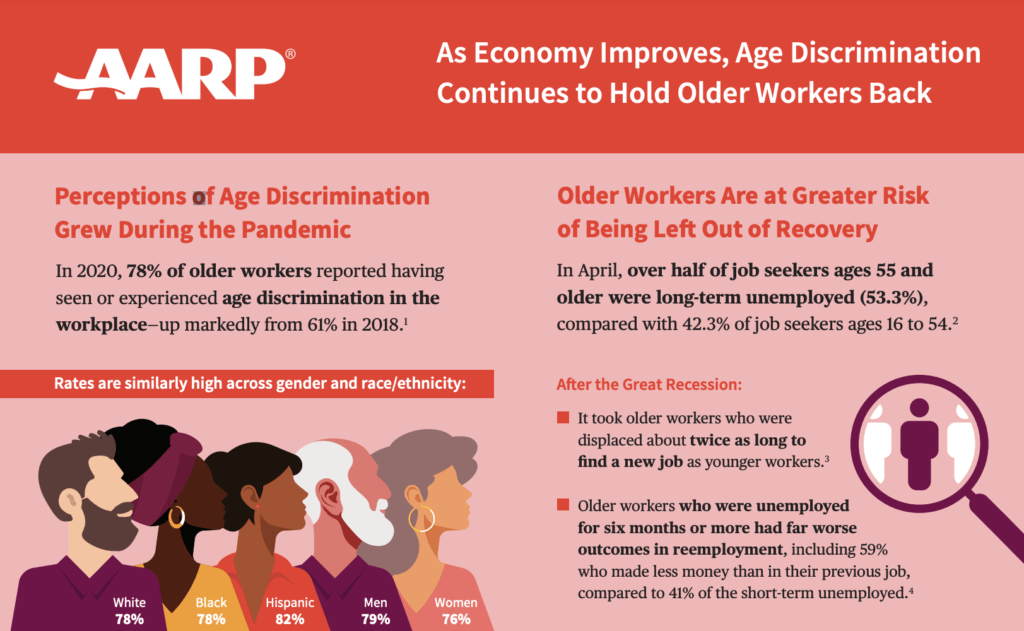
Why Age Discrimination at Workplace?
With 78% of older workers having seen or experienced age discrimination in the workplace, the problem is ubiquitous. So let’s try to understand more about why there is rampant age discrimination in today’s workplace.
Not Productive Enough
First, organizations perceive that younger workers are more productive and it is not worth investing their time to develop or train them. So is it really true that older workers are not productive? Older workers come with more skills and experience. That helps new hire older workers hit the road faster more often.
Retire Soon
So even if the older worker comes with all the skills needed for the job, why is that they face marginalization? Also, in the arena of talent management, organizations perceive older workers would retire soon, so there is no need to consider them as high potential. It is just that people perceive that older workers just don’t have enough runway left before they retire. So there is no need to incorporate them into future talent management processes. The entire premise of this discrimination is that the older workers world retire. Then what is the guarantee that younger workers would also not quit? They could also pursue alternate careers, start their own business, or also retire.
Further more, not elaborated often is that older workers are more stable. Since they are usually not chasing the money and, more often, they are better settled in life. They either work to have a steady income to support their modest expenses, keep themselves busy or stay fit. This might sound weird. Yes, many older workers take up jobs to stay mentally and physically fit.
Not be Suitable for Physically Demanding Jobs
Second, another preconceived notion is that older workers might not do physically demanding jobs. While it might be true if the job is very strenuous like construction work, for most cases, it might not be the case. Older workers, if physically fit, can do a lot of physically demanding work. Again, most times, older workers want to do some physical work just so that they stay fit.
Technologically Backward
Third, there is a prevalent notion that older workers are technologically backward. That they are not up to speed on the latest technological tools and systems. While it again might be the case many times, but just as younger workers train on newer technological tools, can’t older workers also learn then when needed? Because it boils down to how much the older worker wants to do this work? If he or she really wants to do this job for the love of it or the need for it, then why wouldn’t they invest their time learning it? Since there is no right age to learn something. If we are really passionate about doing something, we will most likely find the motivation and the resources to train on it.
Generational Gap
Fourth, there is a prejudice of generational culture gap for older workers. That means older workers have an old school of thoughts and it is difficult for younger generations to intermingle and work together as a team. This might sound pejorative, but is true most times. Today, organizations foster diversity and inclusion. Everywhere there are talks about gender and racial equality. Many times, organizations promote female and African American to foster more inclusion, which is the right thing to do.
But what about older workers? Is age also not part of the diversity equation? Then why can’t we have older workers work side by side with younger workers in a team as colleagues? Why we need to prejudice them as older generations with an old school of thoughts? Diversity is all about bringing diverse thoughts and ideas on to the table so that we can innovate better. Then why would we choose to lose on to the perspectives brought in by older workers?
Does Age Matter at Work?
How Age Discrimination Affects Economy
A report by AARP, The Economic Impact of Age Discrimination, finds that bias against older workers cost the U.S. economy an estimated $850 billion in gross domestic product (GDP) in 2018. And that number likely will grow to $3.9 trillion by 2050.
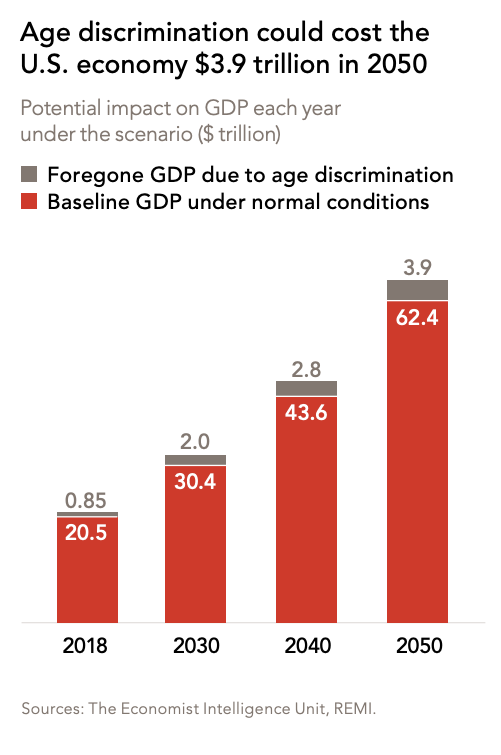
To put in perspective the economic impact of 50-plus population in the US, in 2018 this age group contributed 40% for the Gross Domestic Product (GDP) which is a whopping $8.3 trillion. Further more, the report estimates the 50-plus population is going to contribute $26.8 trillion by 2050.

There are several key reasons the 50-plus population will increasingly contribute to the GDP. These include the population is going to age and life expectancy will increase. We can this corroborate by an already increase in full retirement age, which is now 67 years.
The age discrimination cost of $850 billion on GDP in 2018 affects a wide range of industries, among which finance, insurance and real estate being the most affected.
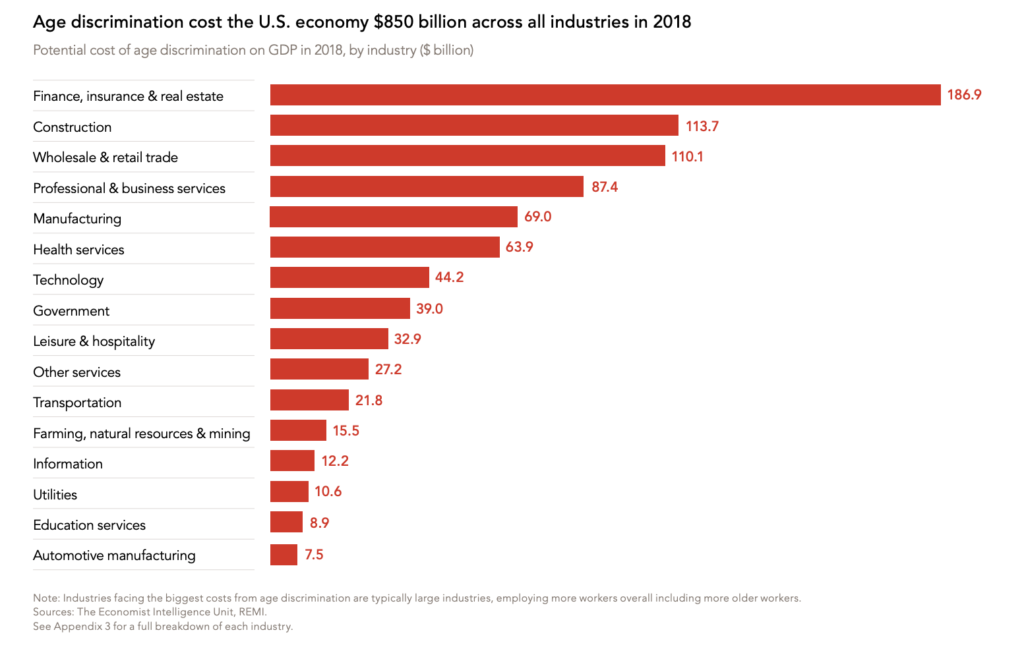
Further more the analysis predicts spending on healthcare, leisure and hospitality will miss out the most due to age discrimination in 2050.

More over if there is no age discrimination, then the 50-plus population contribution to GDP is further going to increase to $30.7 trillion against the current estimate of $26.8 trillion by 2050. The US could miss out on this 15% increase in GDP because of age discrimination.
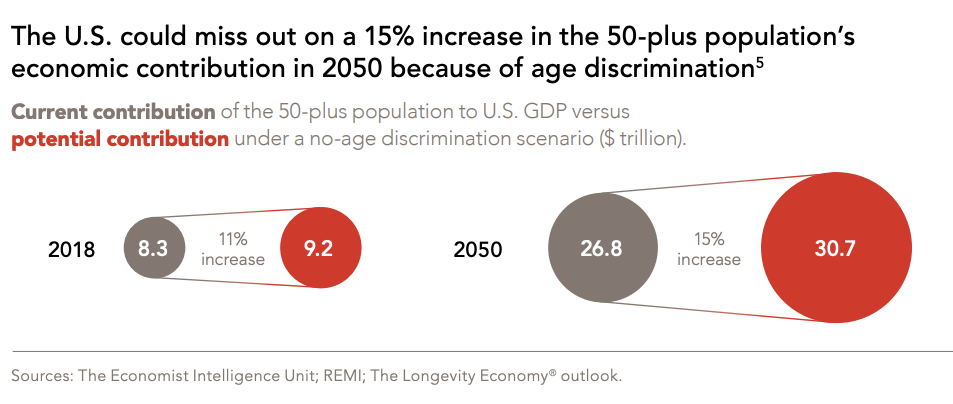
Further more the 50-plus labor workforce has significantly grown in the last two decades.
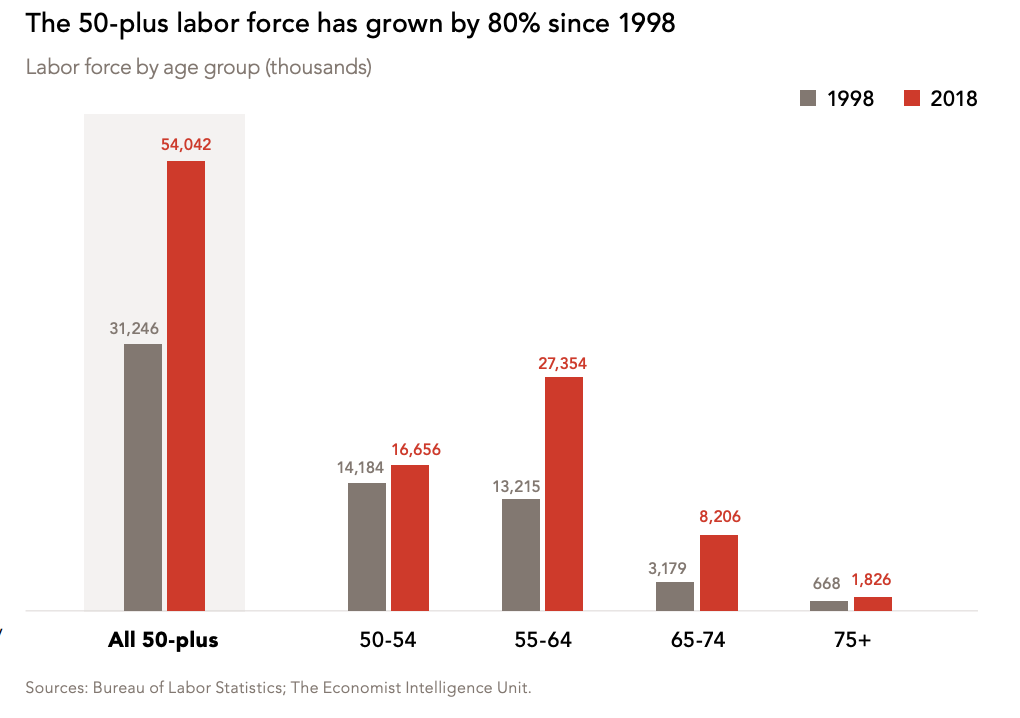
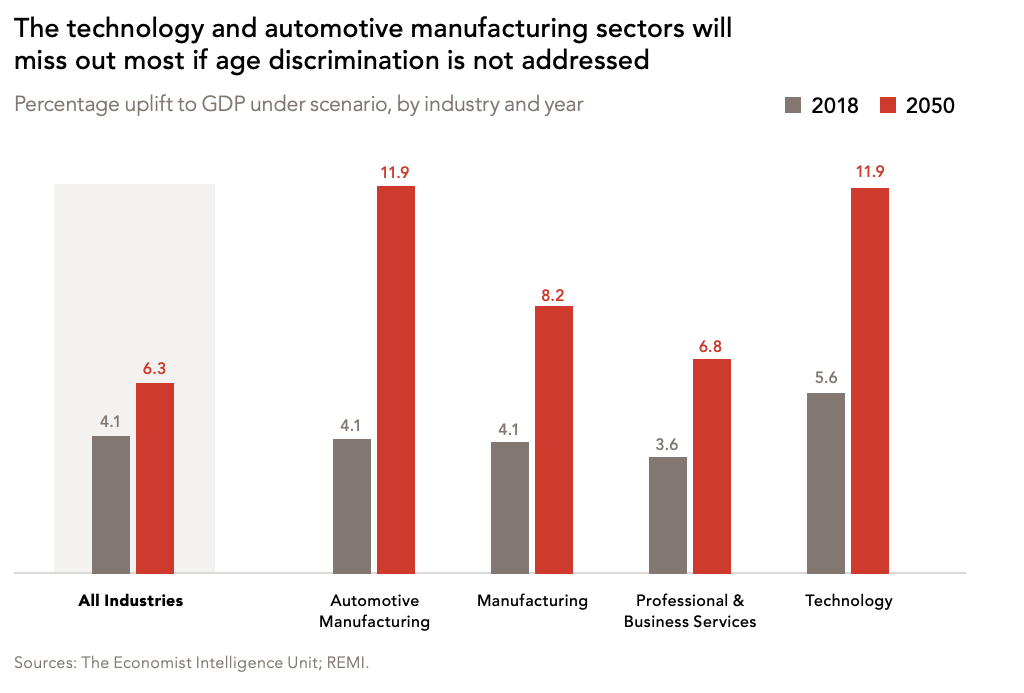
Dynamics of Age Discrimination at Work
So what are dynamics of age discrimination at work? What is the impact on unemployment across the gender, minorities and income groups? Are 50-plus population forced to retire early due to age discrimination? Let’s deep dive into this data. For the 50-plus age group, women experience about 31 weeks of unemployment due to age discrimination. For men, it is a tad less at 29 weeks.

Then again, over the past five years prior to 2018, for men who retired between 50 and 64 about 11 percent were being forced into retirement due to age discrimination. For women, it was a tad less at 7 percent.

Further more, the data also showed that a higher percentage of the lower income bracket felt unable to change jobs because of age discrimination. This is not surprising.
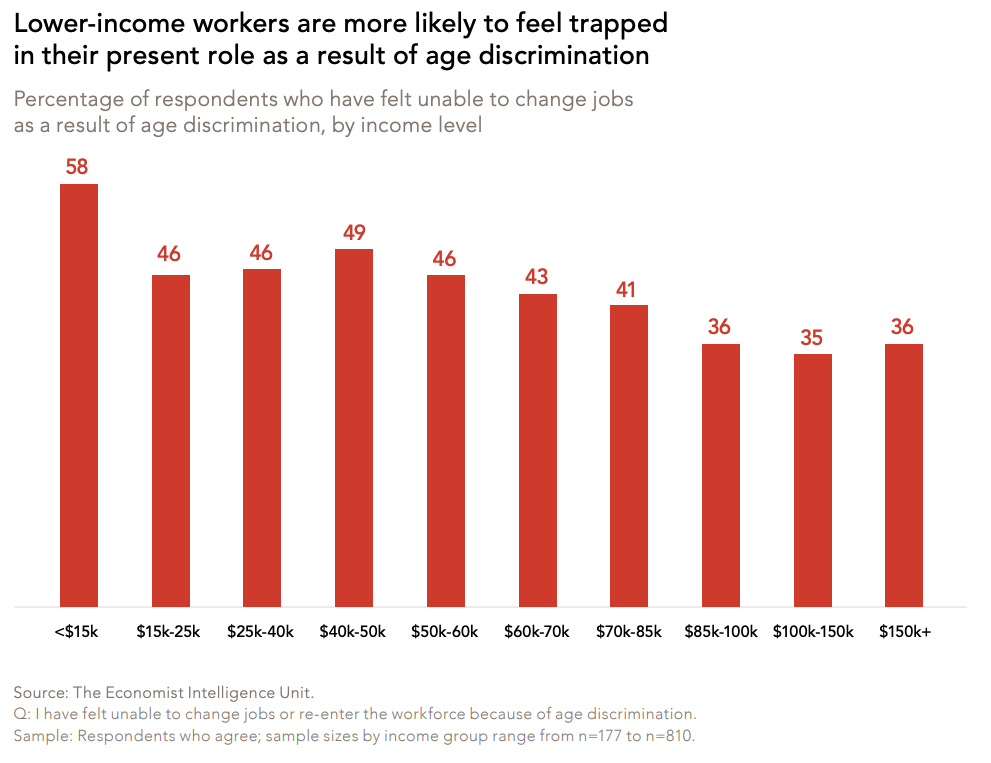
Again, minorities faced the brunt of the age discrimination. With the African Americans facing the highest, at 50 percent felt trapped in their present roles due to age discrimination.
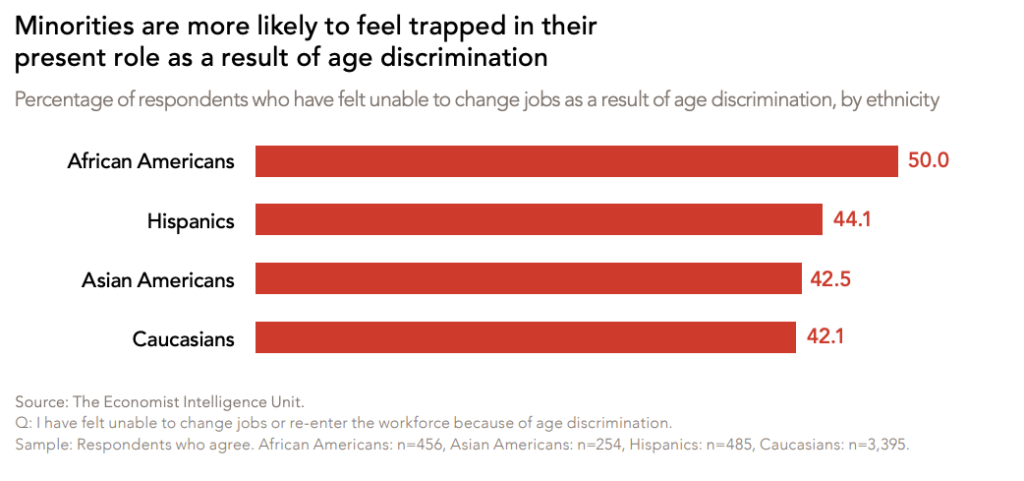
Impact of Age-Based Discrimination on GDP, Jobs and Wages
The report also pulls together a model illustrating the impact of age discrimination on involuntary retirement, underemployment and unemployment on GDP, jobs and wages in the US.
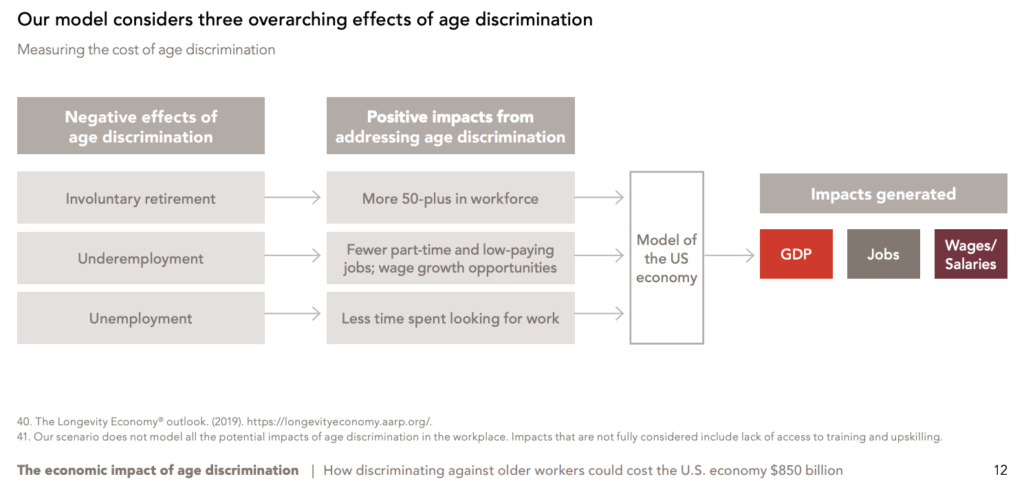
As the data shows below, involuntary retirement due to age discrimination has the highest economic cost, followed by underemployment and unemployment. Underemployment is a measure of how well the labor force is being used in terms of skills, experience, and availability to work. Here again, the economic cost impact of underemployment of women exceeds that of men, with women at 33 percent and men at 24 percent.
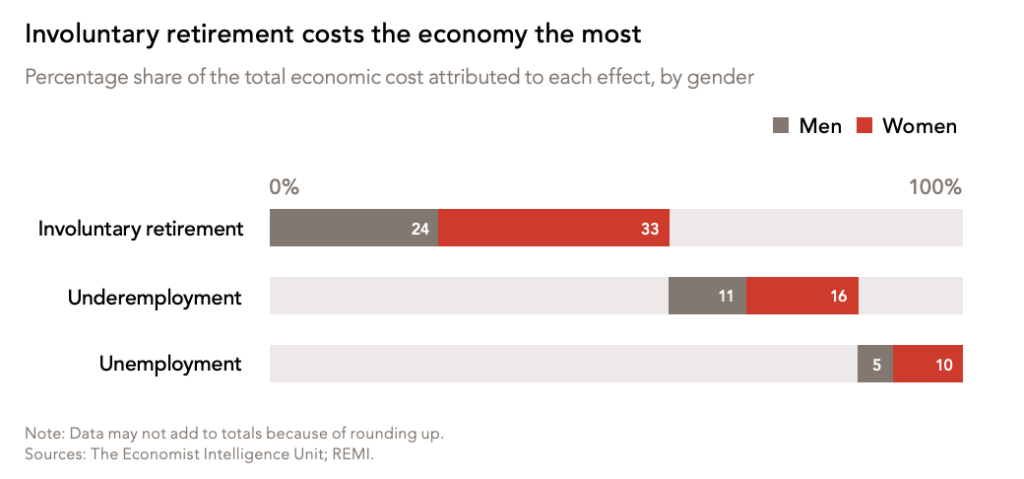
Last, the data shows that in 2050, the technology and the automotive manufacturing sectors will probably miss out most if we do not address age discrimination. We can uplift technology and automotive manufacturing GDP by about 12 percent and overall manufacturing by 8 percent if we tackle age based discrimination.

Why Ageism Undermines Diversity and Inclusion at Workplace
Diversity about is not only gender and race. It is also about building a multigenerational workforce. But why we don’t realize that we need team with broad a based age? Diversity is all about leveraging ideas and thought processes from our differences. Age brings experience, tolerance, and maturity. Thus, we can miss out on tapping a lot of different perspectives from aged employees just because of the wealth of experience they bring in on the table. Further more, younger generations can learn a lot of hard and soft skills from aged employees. Therefore, sometimes it might sound inhuman that we discriminate against people because of their age at the workplace. Because it truly is inhuman.
Age is Just a Number
Don’t we often say that often that age is just a number? It is more for us as aged individuals than others. If we truly believe age is just a number, then it is difficult for others to discriminate against us at work. Because it will boost our confidence and self-esteem at work. As aged employees, we know our value and are cognizant of the value we bring to the table.
Benefits of Older Workers at Workplace
We have been discussing the benefits of aged workers in this post. That includes diversity and inclusion that is critical for fostering innovation at workplace. We also discussed how younger generations can learn many of the skills from older employees. Further, younger employees can leverage aged employees as mentors at the workplace even if they are teammates. That boosts the self-esteem of older workers because they feel valued and welcome in the team.
Many times, older workers work for some supplemental income, since they have saved for retirement and don’t want to deplete their kitty. But want to have a steady cash flow even if it is less since they have already taken care of most of their expenses. Hence, they are most stable at work and jumping from company to company just for money. What they need is a sense of dignity and respect in the workplace. Therefore, a few words of appreciation can go a long way to motivate older workers. Since there is nothing like having a highly motivated workforce that delivers their 200% at work.
How to Deal With Age Discrimination at Workplace
Now if you are an aged worker, say 50-plus, then what do you need to do or know to deal with any age discrimination at work?
Know Your Rights
First, you need to know your rights. In 2020, the house passed Protecting Older Workers Against Discrimination Act (POWADA). Since this legislation strengthens the rights of older workforce who are facing age discrimination in the workplace to avail legal help.
Create Exemplary Value at Work
Second, as true for any age, strive to create exemplary value for your organization at work. This might sound cliched. But there is nothing like being the most sought after employee at the workplace. Then it is just a matter of time when age discrimination melts away. Might sound impossible, but is true. Just try it.
Mentor and Train Younger Employees
Third, we talked about mentoring and training younger employees. It is like giving back to the community expecting nothing back. Again might sound utopian, but there is nothing like self-less contribution. Because as aged workers, we can help the younger generation with the wealth of our experience even if this is for our teammates and beyond the expectation of our pay grade.
Pursue Higher Education and Up-Skill
Fourth, to stay contemporary, it is always good to pursue higher education and up-skill. This might be through pursuing additional degrees, diplomas or certifications that not only enhance our knowledge but also help us get specific skills required or valued at our workplace. Further more, it opens up avenues for newer opportunities at the current workplace or elsewhere. More so, it boosts our self-esteem and confidence at work.
Embrace the Contemporary
Fifth, as older workers we could experience generational gap at workplace. May feel like we are out of place. Still back in the days. But besides expecting others to accept us at the workplace, we also need to embrace the contemporary. Then only the older workforce can truly assimilate in the multigenerational workforce culture. It’s also on us.
Recognize Your Value at Workplace
Sixth, as older workers, we also need to recognize our value at work. What are our strengths and what we can bring onto the table? Realize as we need the work, the company also needs us for the value we add.
Stay Fit and Healthy
Seventh, we need to live to work and not work to live. If we can keep healthy and stay fit, it not only boosts our self-esteem but also changes the way others perceive or accept us. Again, then age can only be a number.
Conclusion on Does Age Matter at Work?
To conclude, does age matter at work? The short answer is yes and no. It also depends a lot on us. How we know and exercise our rights as aged workers. And what we do to create value at work. We might need a little of help. Some understanding from co-workers, managers and leadership at work. But again it is on us how to work on our terms and strive to become invaluable at workplace. That could be because of our quality of work or how we assimilate into the culture of the workplace, living the values of the organization every day. Again, age is just a number. If we want to make a difference to our organizations, community and the world at large, we can even if we are 65-plus year old.

Leave a Reply
You must be logged in to post a comment.